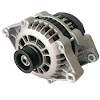Transformers
1. Power Transformers: A power transformer is Used in a substation to step-up (or) Step-Down the voltage. All the power transformers except at generating station are step-down transformers which reduce the voltage rating of electric supply and finally delivers to the Utilization level of the Consumers.
Now-a-days at Substations a 3-phase power transformer (or) 3-Single phase bank of transformers are using. The 3-phase transformer has two advantages as compared to 3-single phase bank transformers, namely
1. Load tap changing mechanism.
2. Installation is simpler that three single phase transformers.
The substation transformer which is installed upon length of rails fixed a concrete slabs having foundations 1 to 1.5 m deep.
For rating upto 10MVA, naturally cooled, oil immersed transformers are used, for higher ratings, the transformers are generally air blast cooled.
2. Instrument Transformers: The lines in substations operate at high voltages and carry current of thousand of amperes. We know that, the measuring instruments meters are designed for low voltages and currents and if these are directly connected to the lines cause these will not work satisfactorily. Hence, to Overcome this difficulty instruments transformers are used.
The function of instrument transformers is to transfer voltages (or) currents in the power lines to convenient values for operation of measuring instruments are relays. There are two types of instrument transformers, namely
1. Current transformer (C.T.)
2. Potential transformer (P.T.)
Current transformer (C.T.): A current transformer is essential a step-up transformer which step-down the current to a know value. The primary winding consists of one or more turns of thick wire and is directly connected in series with the power circuit (the circuit in which current is to be measured) and the secondary winding consists of large number of turns and is connected to the indicating and metering instruments and relays.
Example: A current transformer rated to 100/5A is connected in the line to measure current. If the current in the line is 100 Amp, then the current in the secondary will be 5A.
Similar if the Current in the line is 20 Amp, then secondary of `C.T. will have a current of 1Amp. Hence, the C.T. Will step down the line current by a factor of 20.
Potential Transformers [P.Ts]: It is essentially a step-down transformer and step-downs the voltage in a known ratio. The primary winding of potential transformer consists of a large number of turns and its secondary winding has a few turns. The primary winding is connected to the main bus-bars and secondary winding is connected to the indicating, metering instruments and relays.
Example: If a potential transformer is rated at 66kv/110 volt is connected to a power line. If the line Voltage is 66kv then the voltage across the secondary will be 110 volt.










0 Comments